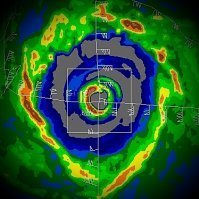-
Posts
4,613 -
Joined
-
Last visited
Content Type
Profiles
Blogs
Forums
American Weather
Media Demo
Store
Gallery
Posts posted by Windspeed
-
-
NHC may have to downgrade based on that last pass.


-
It's struggling. A new convective mass is going up but it looks like the core got tilted and succumbed to dry air in the mid-levels earlier due to the persistent ongoing SSW mid-level flow. Is Marco is still a hurricane? Debatable. Probably still close. Need recon.

-
 1
1
-
-
The really nice convective burst and westward expansion earlier might be beginning to wane. Still very strong SSW flow undercutting the MLC. Pulsing waxing and waning upshear might be the order of the day.

-
[mention=442]Floydbuster[/mention] You slacker!

-
 2
2
-
 1
1
-
-
Marco's problem remains mid-to-upper level SSW flow along forecast track. Plenty of stable Theta-E that will continuously be advecting into Marco's small vortex. It may not be powerful enough to decapitate the MLC from the LLC. Marco may be able to temporarily battle with reoccurring mesos that rotate upshear around the main circulation. But the flow is strong enough to keep Marco's intensity in check and prevent convective expansion around the western CDO. This is not terribly unlike Nate in 2017. Though Nate had a larger circulation to tap heat flux. Marco might gain hurricane intensity briefly depending on when recon is in there to find supportive obs. But I'd imagine it will struggle at borderline upper TS/Cat 1 intensity all the way into landfall. Levi Cowan had a great explanation of Marco's struggle within this environment in his video last night.
-
 5
5
-
-
Good lord that AEW went poof!

-
 1
1
-
-
@Floydbusterupdate the thread.
-
 1
1
-
-
6 minutes ago, WxWatcher007 said:
Seems like the globals have been struggling mightily with these two systems. Just leaves a ton of uncertainty on track and intensity.
Globals are a hot mess right now regardless.
-
 2
2
-
-
Well it is a large wave with a noticeable mid-level circulation. It appears to have exited slightly more north and will pass through the Cabo Verdes. It also has a very nice mid-level moisture envelope around it. Obviously there is very stable dry air, but well NW of the wave itself. SSTs at that latitude are marginal but as it keeps gaining longitude, they do increase to support genesis. We'll just have to keep an eye on it. It is color-coded orange by the NHC with 40% probs in the 5-day outlook.With all of the focus on Laura and TD 14 are there any early thoughts on the next wave to leave Africa?

-
000 WTNT44 KNHC 211456 TCDAT4 Tropical Depression Fourteen Discussion Number 5 NWS National Hurricane Center Miami FL AL142020 1100 AM EDT Fri Aug 21 2020 An Air Force Reserve Hurricane Hunter aircraft flew into the depression a few hours ago, and the plane made two center fixes that were about 35 n mi apart, indicating that there are likely multiple low-level swirls rotating around a common center. A well-defined swirl coincident with the second center fix has become apparent in visible satellite imagery, but for now a blend of the aircraft fixes is being used for the initial position until we can be sure the satellite feature is in fact the one and only center. Flight-level and SFMR winds, outside of heavy rainfall, indicate that the maximum winds remain 30 kt. Deep convection is still lacking in organization, with the heaviest activity well to the north near the Cayman Islands and along the Honduras coast. The depression is moving northwestward, or 305/12 kt, along the southwestern periphery of an Atlantic subtropical ridge and toward a deep-layer trough over the Gulf of Mexico. This northwestward motion is expected to persist for the entire 5-day forecast period, with a decrease in forward speed anticipated while the cyclone approaches the Yucatan coast. The track guidance has slowed down a bit during that time, especially the GFS, and the new NHC forecast is therefore a little slower than the previous forecast. After that time, an increase in forward speed is expected, and the NHC forecast lies to the west of the TVCN model consensus, closer to the GFS, ECMWF, and HCCA scenarios. The structure of the depression aside, the environment still appears conducive for strengthening while the system approaches the Yucatan Peninsula. Vertical shear over the depression is currently less than 10 kt and is expected to remain low for the next 36-48 hours, and sea surface temperatures will be around 30 degrees Celsius. Therefore, steady intensification is shown in the official forecast through 36 hours, and the NHC prediction lies near the upper end of the guidance envelope between the HCCA and HWRF solutions just before the center reaches the Yucatan coast. After some weakening while over the Yucatan Peninsula, re-intensification is likely to occur over the central Gulf of Mexico between days 2 and 3 while vertical shear remains relatively low, and the cyclone could become a hurricane during that time, as shown by the HCCA, HWRF, and HMON models. After day 3, southwesterly vertical shear of 30 kt or more is expected to develop over the northwestern Gulf, and the official forecast follows the trend of all the intensity guidance, showing weakening by day 4 as the cyclone approaches the southeastern Texas or southwestern Louisiana coastline. This forecast remains highly uncertain, however, and users are urged to continue monitoring changes to this forecast over the next couple of days. Key Messages: 1. Heavy rainfall and gusty winds over portions of the coasts of Nicaragua and Honduras, including the Bay Islands, are expected to diminish today. 2. Tropical Depression Fourteen is expected to strengthen over the northwestern Caribbean Sea through Saturday, and it is expected to be near or at hurricane strength when it reaches the east coast of the Yucatan Peninsula of Mexico late Saturday. A Hurricane Watch and a Tropical Storm Warning are in effect for portions of that region. 3. The system is expected to move into the south-central Gulf of Mexico as a tropical storm on Sunday. Some strengthening is anticipated while it moves northwestward over the central Gulf of Mexico early next week, but it is too soon to know exactly how strong it will get or the location and magnitude of impacts it will produce along the central or northwestern Gulf Coast. Interests in that area should continue monitoring the progress of this system over the next few days. FORECAST POSITIONS AND MAX WINDS INIT 21/1500Z 16.6N 84.1W 30 KT 35 MPH 12H 22/0000Z 17.4N 85.0W 40 KT 45 MPH 24H 22/1200Z 18.6N 85.9W 50 KT 60 MPH 36H 23/0000Z 20.0N 86.9W 60 KT 70 MPH 48H 23/1200Z 21.5N 88.2W 50 KT 60 MPH...INLAND 60H 24/0000Z 23.2N 89.7W 55 KT 65 MPH...OVER WATER 72H 24/1200Z 25.1N 91.4W 65 KT 75 MPH 96H 25/1200Z 28.7N 94.1W 60 KT 70 MPH 120H 26/1200Z 31.3N 95.5W 40 KT 45 MPH...INLAND $$ Forecaster Berg -
TD14's low-level vortex is fully exposed right now but very clearly defined on visible. If convection can go up over it this afternoon than strengthening will be in order and this can get named. However, if land-induced convection becomes dominate, there is the possibility of CS collapses and outflow boundaries adversely affecting it. We'll have to see how this evolves, but it definitely still needs work before I would expect Marco in the short-term.

-
 1
1
-
-
RE: Double Trouble and nasty weather...
-
 2
2
-
-
Yeah this is going to get interesting. I can see TD14 getting named first and may even pull off some faster intensification prior to landfall or interaction with the Yucatan. However, it may get sheared heavily in the GOM depending on interaction between upper trough and southerly flow on the western periphery of the large anti-cyclone positioned over the Bahamas in a few days. The exciting thing about this setup is the great amount of uncertainty even among the best tropical meteorologists. Everyone is in wait and see mode. TD13 may still reform a vortex and go bonkers if positioned just north of the GA. Then again it may do nothing and leave TD14 to go at it alone in the GOM. Then there is the public aspect of trying to make a forecast that creates awareness and yet leaves the possibility that one or both systems may not pan out.If those tracks verified, you might see a Fujiwara or the outflow from the larger storm might completely shear the other.-
 2
2
-
-
Making a single thread to cover semi-related, off-topic and non-meteorological discussions for both Laura and Marco. Both systems are going to influence each other directly and indirectly and I am sure frequent postings will heat up enough to warrant it. Speaking of...
-
 1
1
-
-
What the hell is going on with the GFS lately? Sheesh...
-
Race is on here for the L and M names. If recon finds a sufficient low-level vort with TS force and TD14 may win Laura.
Interestingly recon also finds a pretty strong trough over the north-central GOM on its way there. Going to be fascinating watching all these dynamic features evolve with the tropical systems.
-
 2
2
-
-
Watch the low level cloud field. They're starting to align west to east into the convection. Might be the beginnings of something closing off at the surface. Definitely keep watching that if convection can keep firing in the same location of the axis.

-
 1
1
-
-
97L has been pulsing convection this morning. Again, it's a wait and see if that can remain persistent long enough to increase low level convergence and close off a low level vort. No signs yet based on visible. But the potential is still there as long as convection keeps firing. The disturbance does appear to be slowing down its westward motion.

-
 2
2
-
 1
1
-
-
There it is, Chief...

Jokes aside, that is the most impressive sub-Saharan MCS I have seen since Irma. This is going to be fun to track regardless of pattern shenanigans. Granted, Florence's was nice too, but not that intense.
-
 2
2
-
-
Genevieve still has a beautiful structure and warm eye, however, the core eyewall convection has seemingly reached a steady-state plateau and intensification has ceased. This is likely due to something I had forgotten to consider earlier. SSTs...
Genevieve is traversing Elida's wake. Though immediate shallow layer SSTs are likely still 28°C, water below the 26° isotherm in the colder thermalcline has likely upwelled. This may not have even had time to show correctly on SST analysis as this area has been cloud covered.
So there you go, Genevieve has peaked and will probably hold steady until tomorrow when weakening begins.
-
Remnants of Kyle and its energy is phasing with a low pressure system over the Northern Atlantic. Multiple strong systems will blast through the UK this week.
-
 1
1
-
-
-
We've been in an unfavorable phase, but favorable upper 200 hPa vorticity is now spreading over the Atlantic Basin and should have a negative mean through the end of August. Afterwards, a rather neutral phase will persist over the western basin with stronger vorticity remaining over the far EATL/WAM. At any rate, you don't need a strong MJO, you just don't want to see a suppressive regime dominating the entire basin. Upper divergence should persist over the WAM through peak season to keep strong AEWs exiting the African continent.We are supposed to be in a suppression phase the next 2 weeks anyway, this is just bonus Invests to trackSent from my LML212VL using Tapatalk
-
 2
2
-
-



.png.c5dd4bece24576c01ee49d03261d807c.png)
2020 Atlantic Hurricane Season
in Tropical Headquarters
Posted